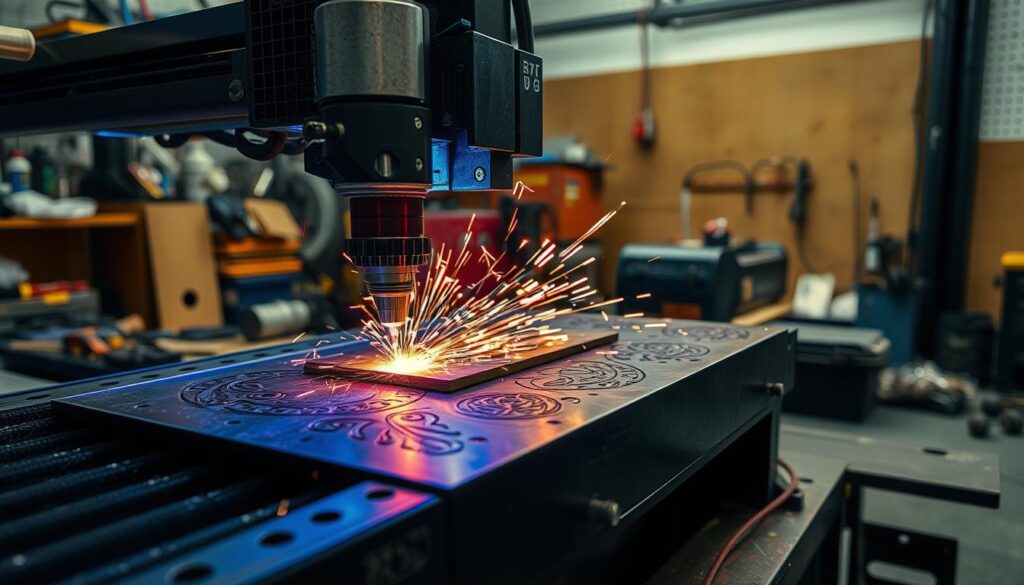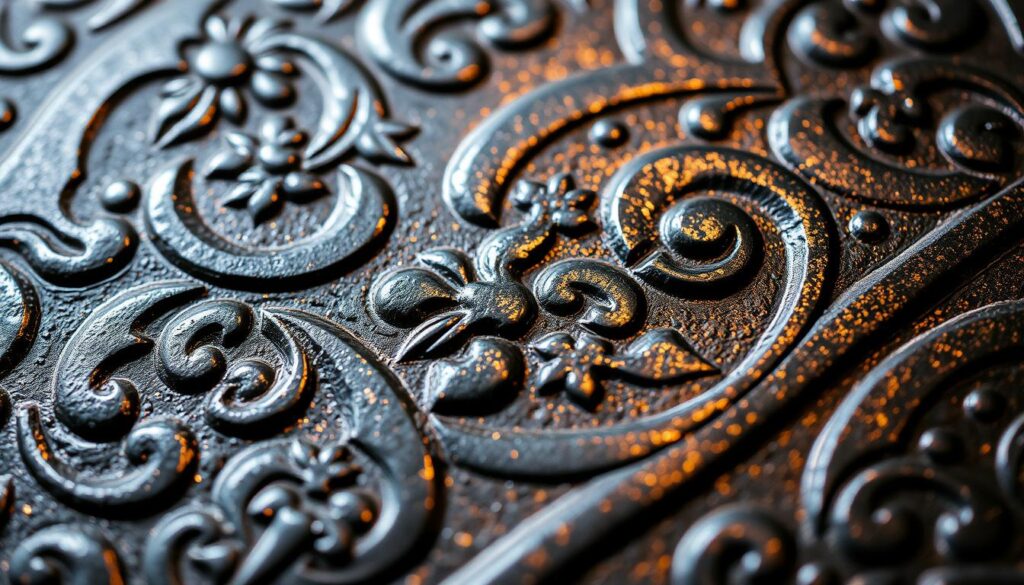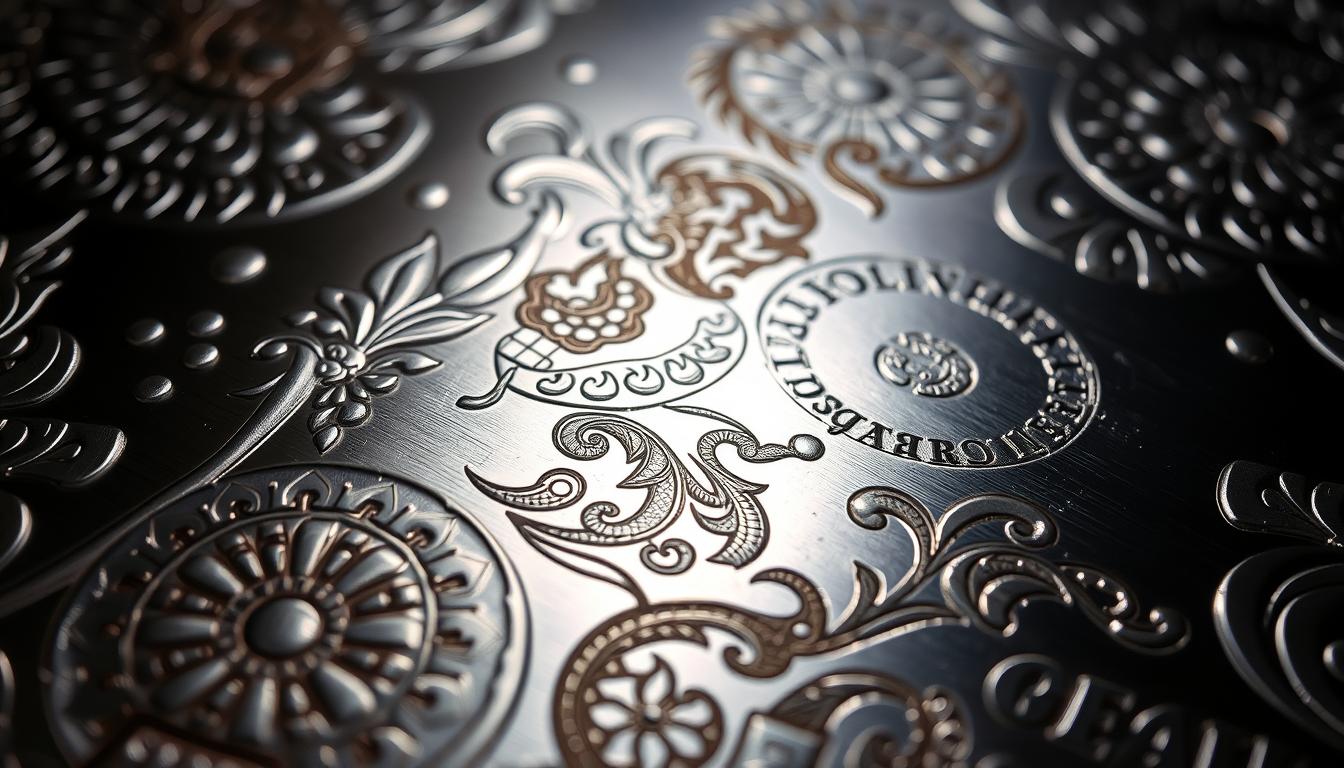Laser engraving on iron uses focused light to make permanent marks on the metal. To improve these marks, you can prepare the surface, adjust laser settings, and use post-processing techniques. These steps help make laser engravings on iron look better, for both work and art.
Iron is a common metal that laser engraving can enhance. The look of these marks depends on the metal’s surface, the laser settings, and the design. By controlling these factors, experts can make laser-engraved iron products look and work better.
Understanding Laser Engraving Technology for Metals
Laser engraving on metals is precise and versatile. It uses high-intensity light to change surface properties. This technology works by vaporizing and oxidizing materials, making permanent marks on metals.
Basic Principles of Metal Laser Marking
Laser engraving on metals uses a focused light beam. It can melt, evaporate, or oxidize the metal surface. The markings’ depth and look depend on laser power, pulse duration, and metal type.
Types of Laser Engraving Processes
There are different laser engraving processes for metals. These include laser engraving, laser marking, and laser etching. Laser engraving removes material to create cavities. Laser marking changes the metal’s surface without removing much material. Laser etching heats the metal to make raised marks.
Key Components of Laser Engraving Systems
Good industrial laser marking and permanent metal marking systems have key parts. These include the laser source, beam delivery system, and control software. Fiber lasers, CO2 lasers, and diode lasers are common for metal laser branding. The beam delivery system and software control the laser’s intensity and pattern.

Knowing laser engraving’s principles and system components helps manufacturers. They can make high-quality, durable marks on metals like stainless steel and titanium.
Essential Surface Preparation Techniques
Getting the iron surface ready is key to better laser engraving. This means making sure the metal is clean and ready for engraving. Let’s look at the main steps to get iron looking great and lasting longer.
Cleaning the Surface
Cleaning the iron first is crucial. It gets rid of oil, grease, and oxidation that can mess up the engraving. Using the right cleaners and methods makes the surface perfect for engraving.
Polishing for Smooth Finishes
Polishing the iron is also vital. It makes the metal smooth, which helps the engraving look even better. This step is especially important for top-notch metal marking.
Addressing Surface Oxidation
Iron can oxidize, which can mess with engraving. Using special treatments or coatings helps keep the surface clean. This makes the engraving sharper and clearer.
| Material | Laser Engraving Characteristics | Surface Preparation Considerations |
|---|---|---|
| Aluminum | Quick and efficient marking properties | Cleaning to remove contaminants, polishing for smooth finish |
| Stainless Steel | Resistant to corrosion, provides clear, permanent marks | Deoxidation treatment, polishing for uniform texture |
| Brass | Distinctive gold-like appearance for decorative arts | Cleaning, polishing, and potentially lacquer coating |
| Titanium | Strength and lightweight properties for aerospace and medical | Cleaning, polishing, and specialized coatings |
Using these surface prep techniques improves laser engraving on iron. It makes iron customization and metal marking look professional and last longer.

Laser Engraving on Iron: Best Practices and Methods
To get the best look from laser engraving on iron, you need to balance a few things. Adjusting power and speed, focusing the laser, and designing patterns carefully are key. This way, you can create stunning engravings that highlight iron’s durability and beauty.
Power and Speed Settings Optimization
Getting the right power and speed is crucial for laser engraving on iron. More power means deeper engravings but too much can damage the metal. Slower speeds help with details but might overheat the iron. Engravers often try different settings to find what works best for their projects.
Focus and Beam Quality Control
Keeping the laser focused and its beam quality sharp is essential for clear engravings. Good focus means the laser hits the iron just right, creating clean lines. Also, checking the beam’s intensity and steadiness helps avoid any mistakes in the engraving. Keeping your laser system in top shape is key to achieving this precision.
Pattern Design Considerations
When designing for laser engraving on iron, consider the metal’s grain and heat conductivity. Iron’s toughness can make detailed designs harder than on softer metals. Skilled engravers adapt their designs to work well with iron, making the most of its natural look.
By following these best practices, laser engravers can fully use iron’s potential. They turn its surface into a canvas for beautiful, high-quality engravings that show off iron’s elegance and strength.
| Engraving Method | Pros | Cons |
|---|---|---|
| Laser Engraving |
|
|
| Hand Engraving |
|
|
| Power Tool Engraving |
|
|
| CNC Engraving |
|
|
Advanced Enhancement Techniques for Metal Marking
Laser engraving is getting better, and so are the ways to make metal markings look and last longer. Using special laser wavelengths helps a lot. These wavelengths make the markings on iron deeper and more colorful, without needing more power.
Another cool method is multi-pass engraving. This means the laser goes over the same spot many times. Each time, it makes the design deeper and clearer. It’s great for making detailed patterns and textures on iron.
Pulse shaping technology is also a big deal for industrial laser marking. It lets engravers control the laser pulse to avoid heat damage. This way, they can get sharper, more detailed laser etching on iron. It opens up new ways to customize and personalize in industrial settings.

Leave a Reply